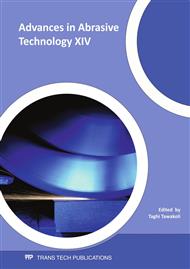p.35
p.42
p.48
p.54
p.60
p.66
p.72
p.79
p.85
Analysis of Effective Cutting-Edge Distribution of Grinding Wheel Based on Topography of Working and Ground Surfaces
Abstract:
In this study, the determination method of the number of the effective cutting-edges had been proposed based on the measurements of working surface topography and the grinding force. Furthermore, its validity is made clear based on the topographical analysis of the ground surface roughness of pure copper, which is excellent in transcribing the working surface. From the results, the following are found out: The ground surface topography contains the periodical component, which is originated in the grinding and dressing conditions, on the fractal noise component. The cutting traces by each cutting-edge can be countable from the ground surface profile, and then, the number of the effective cutting-edges is identified at one line within the working surface. On the other hand, the number of the effective cutting-edges also can be identified based on the working surface, but, this method requires the determination of the typical grain shape. From the experiment, it is confirmed that the grain shape should be almost spherical for making the numbers of the effective cutting-edge identified from the working and ground surfaces equal.
Info:
Periodical:
Pages:
60-65
Citation:
Online since:
August 2011
Price:
Сopyright:
© 2011 Trans Tech Publications Ltd. All Rights Reserved
Share:
Citation:


